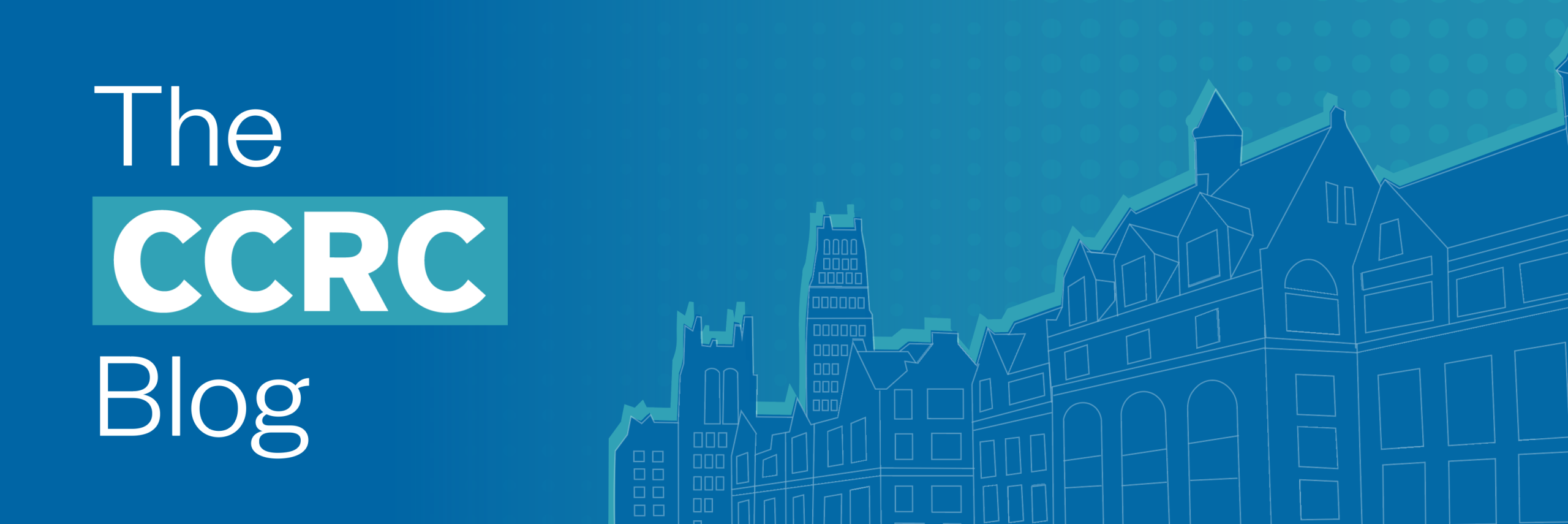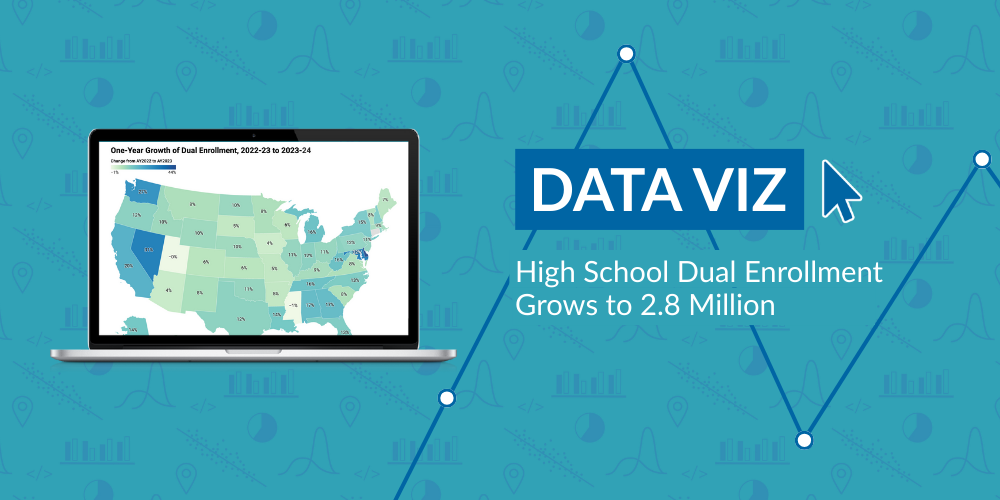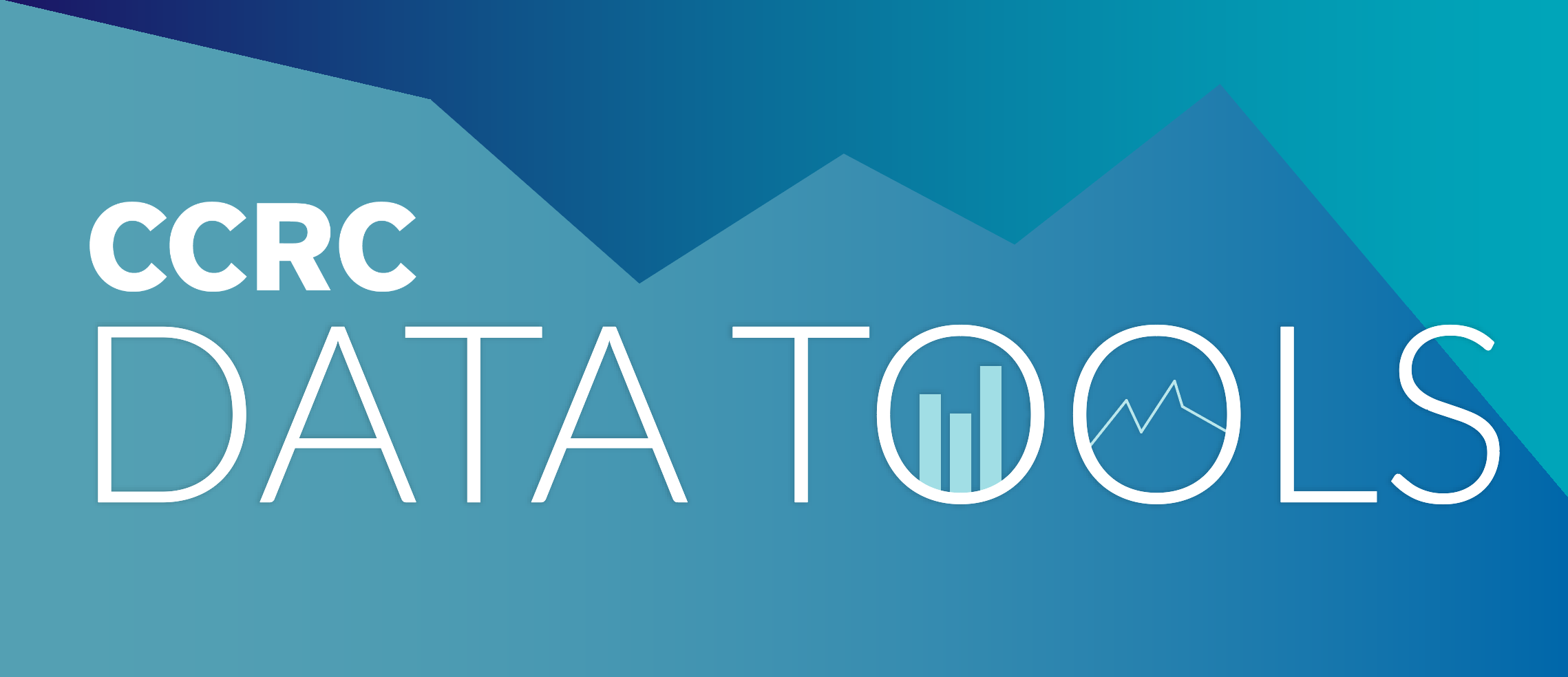Newly released data from the U.S. Department of Education’s Integrated Postsecondary Education Data System (IPEDS) offers the most recent and comprehensive view of the scale of high school dual enrollment programs at postsecondary institutions across the country. In the 2023-24 academic year, there were 2.8 million dual enrollment students—a 12.7% increase over the prior year. That’s 300,000 additional students taking college courses in high school.
Community colleges enrolled 2 million dual enrollment students in 2023-24, an increase of 200,000 students from one year prior. But the continued expansion of dual enrollment is not isolated to community colleges or a few states. Rather, colleges and universities have expanded dual enrollment opportunities for students in nearly every state and the majority of communities across the country.
Note: There were two larger institutions (>5,000 dual enrollment students in 2023-24) that apparently underreported dual enrollment counts in 2022-23 (the first ever data collection) and have since corrected their institutional reporting procedures. They reported much larger numbers in 2023-24. These two institutions reported a total of approximately 30 dual enrollment students in 2022-23, compared to a total of approximately 25,000 dual enrollment students in 2023-24.
Given the potential of dual enrollment as an on-ramp to college and career success, particularly for students from underserved communities, this growth represents an opportunity to increase postsecondary attainment on a large scale. Here are some key takeaways from an initial look at the updated 2023-24 data; for more analysis see my 2024 blog post, which will also walk you through CCRC’s Dual Enrollment Participation Dashboard showing dual enrollment headcount by college and state.
Access CCRC’s Dual Enrollment Participation Dashboard to view IPEDS data for your college or state.
Widespread Growth of Dual Enrollment Across States and Colleges
From academic years 2022-23 to 2023-24, the number of dual enrollment students increased in 47 states plus the District of Columbia. The median state grew dual enrollment by 10%. There were 26 states with double-digit dual enrollment growth from 2022-23 to 2023-24, with particularly large gains in Delaware (+44%), Maryland (+32%), Nevada (+31%), Washington (+27%), and California (+20%).
Community colleges served 2 million dual enrollment students in 2023-24, more than any other postsecondary sector, with 71% of all dual enrollment students taking their courses at community colleges. Eighty percent of community colleges continued to grow their dual enrollment programs from 2022-23 to 2023-24: of the 909 community colleges with valid enrollment data, 732 grew their dual enrollment programs, including 228 community colleges that grew dual enrollment by 20% or more, and 49 that grew dual enrollment by more than 50%. Another 171 community colleges saw declines in dual enrollment, including 52 that marked double-digit declines.
Public four-year and private non-profit four-year institutions reported the largest percentage gains in dual enrollment, growing by 18% and 14%, respectively, compared to 12% in the community college sector. The overall growth of dual enrollment students across all sectors means that four-year institutions will continue to serve a growing number of “stealth transfers”—freshman entrants after high school with prior dual enrollment credits.
A Substantial and Increasing Share of Community College Enrollments
Dual enrollment continues to grow in significance for overall community college enrollment. In 2023-24, dual enrollment comprised 22% of community college enrollment, up from 21% in 2022-23. In comparison, dual enrollment comprises only about 6–7% of four-year institutions’ undergraduate enrollments, though this increased about a percentage point from the year prior. In 11 states, more than a third of community college students were in high school, and in two states more than half of community college students were in high school (60% in Idaho and 54% in Indiana).
At the average community college, dual enrollment students comprised 26% of overall enrollment in 2023-24. At 266 community colleges, dual enrollment students comprised a third or more of total enrollments, including 54 community colleges where dual enrollment represented more than half of total enrollment.
The proportion of total enrollments from dual enrollment increased in 2023-24 at 655 community colleges. While this growth is relatively slow at the typical college, up only about 1 percentage point, 92 community colleges increased the share of overall students who are in dual enrollment by 5 percentage points or more.
Representation in Dual Enrollment by Student Race/Ethnicity
Nationally, several racial/ethnic groups of students were underrepresented in dual enrollment compared to their high school and undergraduate enrollments. For example, Black students comprised 14.8% of ninth through 12th grade enrollments in fall 2023 but only 8.1 percent of dual enrollment students in 2023-24. And Hispanic students comprised 29.6% of ninth through 12th grade enrollments but only 20.7% of dual enrollment. These student groups were also underrepresented in dual enrollment compared to undergraduate enrollments overall. In 2023-24, Black students were underrepresented in dual enrollment compared to undergraduate enrollments in every state except Massachusetts, where they comprised 10.3% of dual enrollment and 9.9% of undergraduate enrollment (as well as 9.6% of K-12 enrollment). Though missing race/ethnicity data may explain some of the differences in representation, it is unlikely that it fully explains the underrepresentation of Black, Hispanic, and other students.
Taking a dual enrollment course can be particularly beneficial for Black, Hispanic, and other groups underrepresented in higher education, yet gaps in access to dual enrollment are persistent and widespread, as shown by this updated IPEDS data and numerous prior reports. With fewer than half of colleges (44%) reporting that they disaggregate the demographics of their dual enrollment students to identify underrepresented groups, these new IPEDS dual enrollment data are important since they provide all postsecondary institutions with public, disaggregated data showing which groups of students are underrepresented in dual enrollment.
Findings from our field research studying effective dual enrollment programs shows that it is possible to broaden the benefits of dual enrollment by expanding outreach to underserved high schools and communities, removing unnecessarily barriers to participation, and increasing academic supports, advising, and alignment of dual enrollment coursework to college and career pathways. To support improvement planning around your dual enrollment program, find your college’s specific results in the dashboard below and review our related resources for assessing your college’s dual enrollment practices.





